New Word Teaching: A Look Inside Some PrAACtical Therapy Sessions
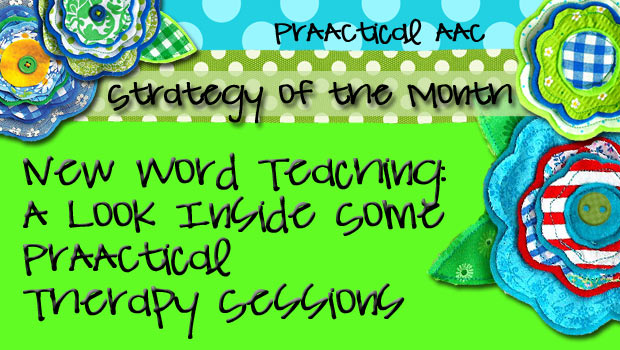
Since we’ve been talking about vocabulary instruction, we thought it might be fun to take a peek inside some therapy sessions where new words were being taught. In the examples below, we were teaching a core word and a Tier 2 vocabulary word over a few sessions. Here are some excerpts with their key intervention principles and practices.
Target Words: do/did as an auxiliary (not main) verb
Activities:
- Introduced a Visual Support (anchor chart): This explained the concept of ‘Helping Verbs,’ provided information on how they are used, listed them, and
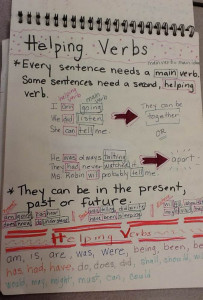 provided examples. These are effective tools for initial teaching, but are also invaluable for ongoing instruction. We use them extensively in language therapy, referring back to them often when we want to reinforce correct responses (look back at the visual together to further solidify the concept), help ‘fix’ incorrect responses (reteaching the pieces that didn’t stick), and facilitate self-correction (a subtle gesture toward the chart can help the learner re-evaluate what they said). We love tools that serve a multitude of purposes.
provided examples. These are effective tools for initial teaching, but are also invaluable for ongoing instruction. We use them extensively in language therapy, referring back to them often when we want to reinforce correct responses (look back at the visual together to further solidify the concept), help ‘fix’ incorrect responses (reteaching the pieces that didn’t stick), and facilitate self-correction (a subtle gesture toward the chart can help the learner re-evaluate what they said). We love tools that serve a multitude of purposes. - Said the Word Several Times in Context: By peppering our speech with the target word, the learner gets multiple examples of how it should be used. Focused language stimulation accelerates the learning process.
- Elicited the Word Several Times: Frequent production of new words (or, in this case, new uses of words) is a key component of effective vocabulary intervention. The more we say it, the more fluent we become. The more fluent we become, the more likely we are to say it spontaneously.
- Used Contrast: We mobilized the power of contrast to examine the use of these words as main verbs versus auxiliary verbs. To do this, we created a list of sentences where the verb was clearly an auxiliary and others where it was a main verb. As we went through the list, we labeled the sentence as Yes (helping verb) or No (main verb), and discussed WHY we applied that label.
- Practiced the Motor Pattern: What happens when you practice did go, did know, did say, did go, did want, did like, did walk, and did think? You get better at did+another verb. Which is exactly the point.
- Used an App: We needed more practice and decided to ‘re-purpose’ an app, in this case, Conversation Therappy (Tactus; You can try the lite version here). Although not designed to work on auxiliary verbs, they have great photos. We used those to make comments that had do/did. The learner’s job was to listen and decide if it was functioning as a main verb or a helping verb.
Target Word: sufficient
Activities:
- Did a Self-Rating: It helps to start out having learners consider what they already know about the word. Teaching a word they never heard before is different
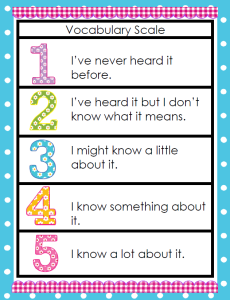 than teaching them a word they already know something about.
than teaching them a word they already know something about. - Provided a Student-Friendly Definition: “Just enough” (not too much, not too little)
- Completed a Semantic Web: We talked about the part of speech, antonyms and synonyms, and other forms of the word.
- Listened to How It Sounds in the SGD
- Talked About Whether to Program It in the SGD: In this case, we decided not to.
- Used it in Context Several Times: “It was freezing in Chicago. I didn’t have clothes that were sufficiently warm.” “Is there sufficient time for us to do one more?” “Her mama won’t let her go to school in that. The skirt is not sufficiently long.” “Do you think I did a sufficient job in filling out that form?”
- Did a Judgement Task: I gave a bunch of examples and the student gave a thumbs up if it was something that WAS sufficient or a thumbs down if it was NOT an example of sufficient. E.g., a girl who is starving at lunch and her mom only packed raisins in her lunch box; a guy who got $20.00 from his aunt and wants to buy a CD for $16.00
- Did a Vocabulary Sort: We took a pile of pictures from our therapy materials, magazines, and the internet that were pre-selected based on one characteristic: some showed good examples of of the concept and some showed non-examples (negative examples) of the concept. As we looked at each one, we discussed where it belonged: sufficient or NOT sufficient.
- Added it to a Word Notebook: It’s good to keep a running list of new words so we can refer back to them.
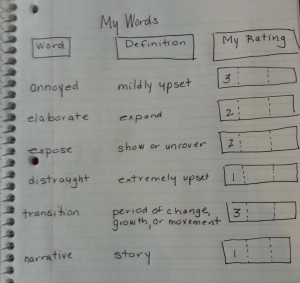
- Elicited it Often: Having the learner say the new word frequently is a good way to help them begin to incorporate it into their expressive vocabularies.
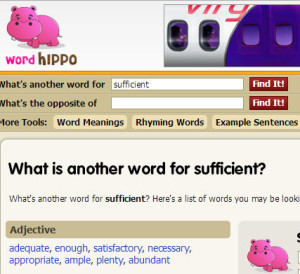
- Used an Online Dictionary: Our current favorite is a site called Word Hippo.
- Planned a Language Experience Survey: We’re hoping to have sufficient time next week to ask people in our clinic to tell us about a time when they got into trouble because they wanted to buy something and didn’t have sufficient funds for it. You can read more about language experience surveys here.
There were lots more things we could have done, but there wasn’t sufficient time.
(
Do you have favorite ways of teaching vocabulary? We would love it if you took a minute to share that below.
Filed under: Strategy of the Month
Tagged With: anchor chart, semantics, visual support, vocabulary
This post was written by Carole Zangari


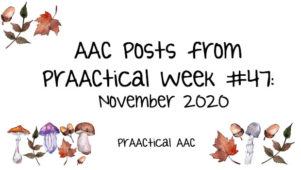

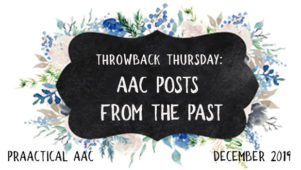
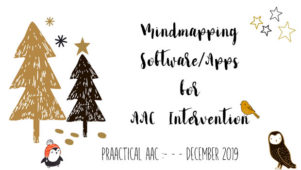
1 Comment
I like to do and have done the personal word dictionary. That works very well when students are faced with unfamiliar words. I love the idea of the rating scale. Will be trying that out soon. Ty for wonderful ideas.